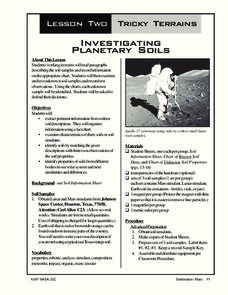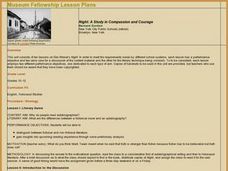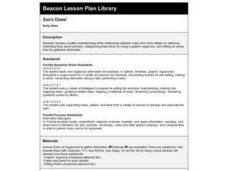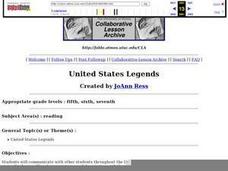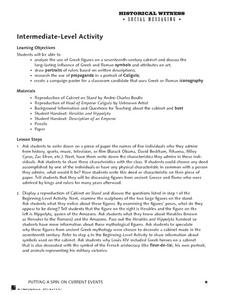Curated OER
Lesson 2: The Tired King
Students are introduced to the three functions of government (legislative, judicial, and executive). They read and discuss a story about an overworked king who must handle all the tasks of government. Students give a description of the...
Curated OER
Jamestown
Seventh graders examine life at the Jamestown settlement. In this colonial America lesson, 7th graders visit the noted Web site to analyze artifacts from the settlement. Based on their findings, students write descriptive pieces about...
Curated OER
Illustrate the Constellations
Learners explore space science by participating in a star identification activity. In this astronomy lesson, students identify different star patterns and discuss the movement of stars across the sky as the seasons change. Learners...
Curated OER
Investigating Planetary Soils
Students study soil characteristics and identify properties of soils from different parts of the solar system. In this soil lesson students divide into groups, read soil descriptions, test and record soil samples.
Curated OER
"Night": A Study in Compassion and Courage
Students read the novel, "Night" by Elie Wiesel. Using excerpts from the novel, they complete a performance and literary technique objective. In groups, they finish handouts to give them more information on the Holocaust. They compare...
Curated OER
Zoo's Clues!
Students determine the difference between major and minor details after researching animals and completing graphic organizers. They write descriptive paragraphs for classmates to guess what animal is being described.
Curated OER
United States Legends
Students learn about legends in different states by communicating with students from different states. They exchange pictures and description through the Internet.
Curated OER
Design Your Dream Room
Students determine length, width, perimeter, and surface area, and work with two-dimensional representations of three-dimension objects to design and write descriptions of their dream bedrooms.
Curated OER
Exploring the Galapagos
Learners explore the species found in the Galapagos Islands and practice descriptive writing skills by creating a sample journal. They create a fictional journal that documents the places they visit and the species they encounter.
Curated OER
Pop on the Block
Young scholars consider what makes a movie, television show, musical talent, or artist a cult classic and create descriptive lists of items from these phenomena that may be sold at auction.
Curated OER
Something Fishy?
Students try to draw and identify a jellyfish from a physical description. After reading an article, they discover new information about cnidarians. In groups, they research and develop dioramas about a specific cnidarian species. They...
Curated OER
Simple Keys and Nutrition
Third graders identify descriptive questions as a method for distinguishing objects and for identifying labels for objects and categorizing objects. They participate in a student grouping activity, then using pictures of different types...
Curated OER
Waking Up, Stepping Out
Students focus on a rich and colorful description of a culture unfamiliar to most of them. They compare the similarities and differences they find between Nepali culture and their own and determine our similarities as people can bridge...
Curated OER
Reaching for the Sky
Students consider features of skyscraper using descriptive words, reflect on notion of skyscraper as orientation point in a city, and explore New York Times Building in Manhattan by reading and discussing article, "Pride and Nostalgia...
Curated OER
Greek and Roman Symbolism
Students explore Greek and Roman symbolism in art. In this visual art lesson, students draw portraits of ancient leaders based on the written descriptions they read about them. Students also design campaign posters using Greek or Roman...
Curated OER
Poetry Reading
Students express the ideas of a poem. In this poem dramatization lesson, students analyze poems for meaning studying their descriptive words. Students role play the descriptive language of the poem. Students draw a picture of the...
Curated OER
Words That Hold Court
Students research legal terminology used in the Supreme Court. In this legal terminology lesson plan, students study a quote from President Obama about the Supreme Court. Students make a list of facts about the Supreme Court and the...
Curated OER
Imaginary Insect Zoo
Students create imaginary insects that contain essential characteristics of an insect, such as six legs and three body parts. In this Science/Arts instructional activity, students distinguish between an insect and non-insect. ...
National Endowment for the Humanities
Seeing Sense in Photographs & Poems
Learners analyze photographs and poetry as forms of each other. In this poetry and photography analysis lesson, high schoolers use the photographs of Alfred Stieglitz and poetry from William Carlos William to explore how poetry and...
Curated OER
Low and High with Ives
First graders read the Poem "The Elephant" by Shel Silverstein and create a descriptive web in the shape of an animal. In this cross curricular music lesson, 1st graders recite a poem with rhythm, then listen to the song "The...
Curated OER
Hanukkah Fun: The Dreidel Game
Celebrate Hanukkah with an engaging lesson about the history of the dreidel! After reading or listening to a short description of the dreidel's place in the Hanukkah celebration, young learners work on their own dreidels from classroom...
Curated OER
Joltin' Joe Has Left and Gone Away
Learners assess admirable qualities in entertainers. They discuss Joe DiMaggio's obituary, focusing on his accomplishments and place in American society. They research and create their own descriptive biographies of athletes and...
Curated OER
DNA AND BLOOD TYPING
Students list three descriptive characteristics and three functions of DNA, describe two ways that genetics is important in a forensic investigation, and list the four major human blood types.
Curated OER
Designing Future Houses
Students discuss the changes we face and what kind of future house designs students can imagine. They create a floor plan, make an architectural drawing, and write a short description about their future house.



